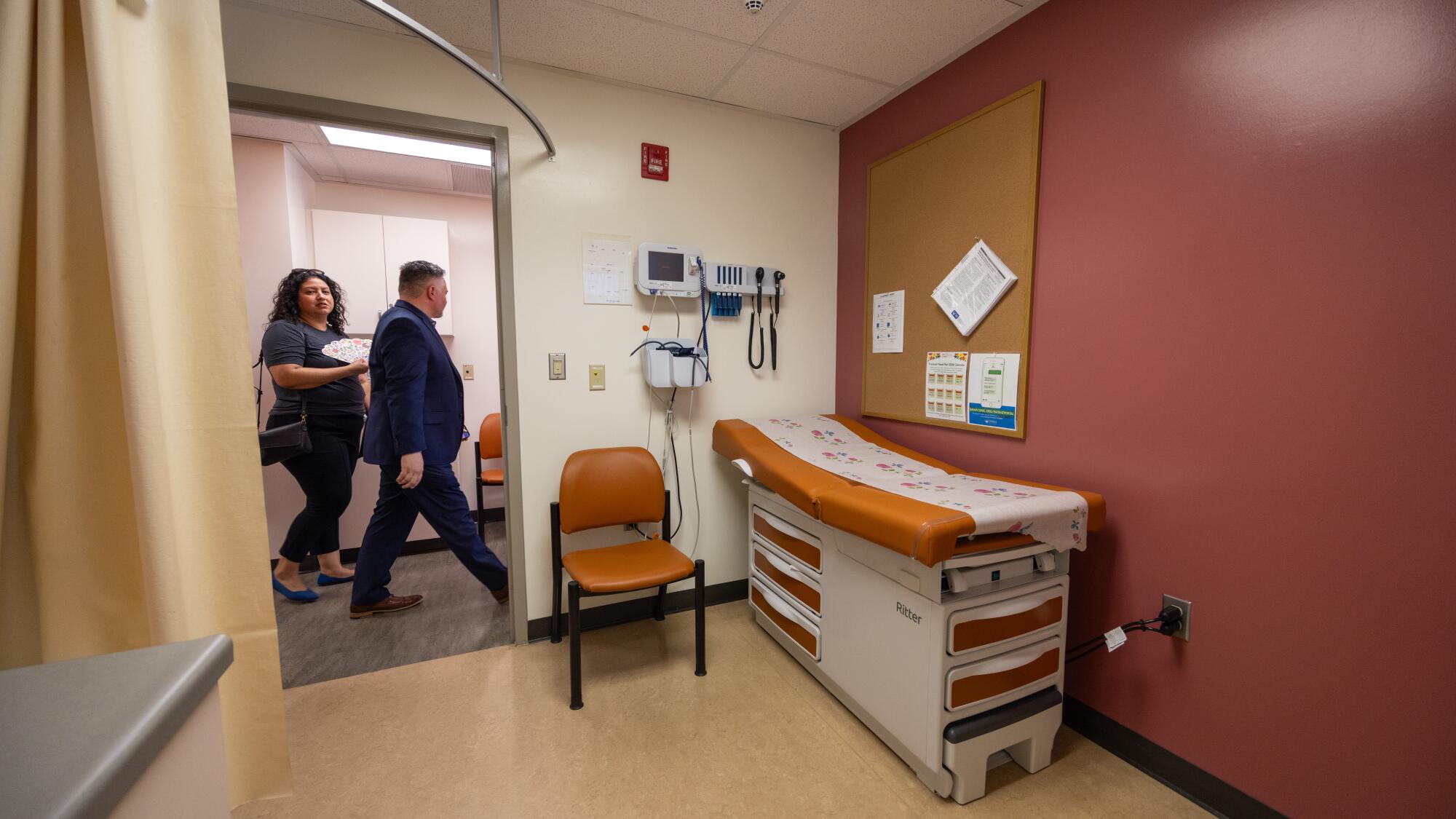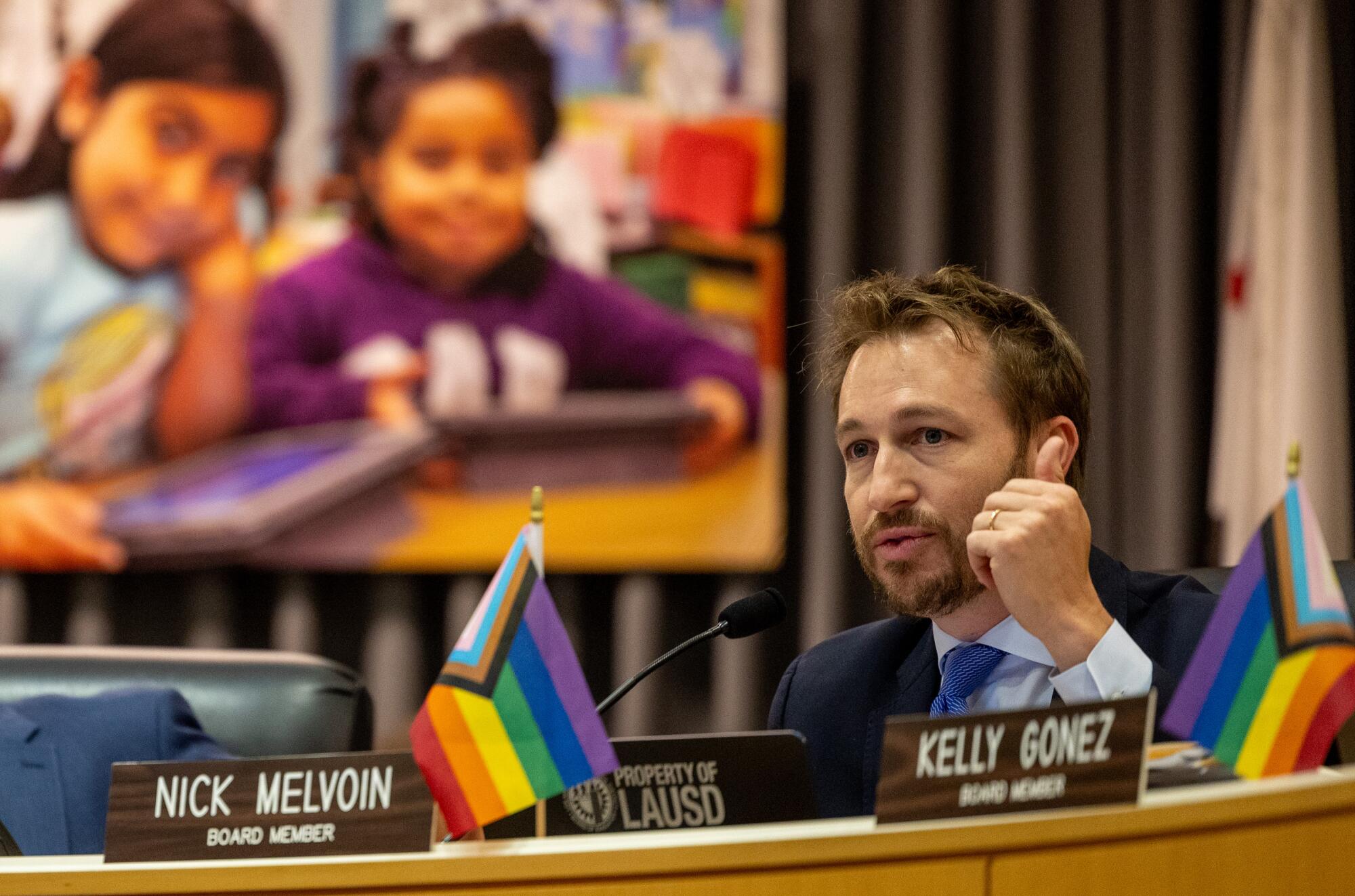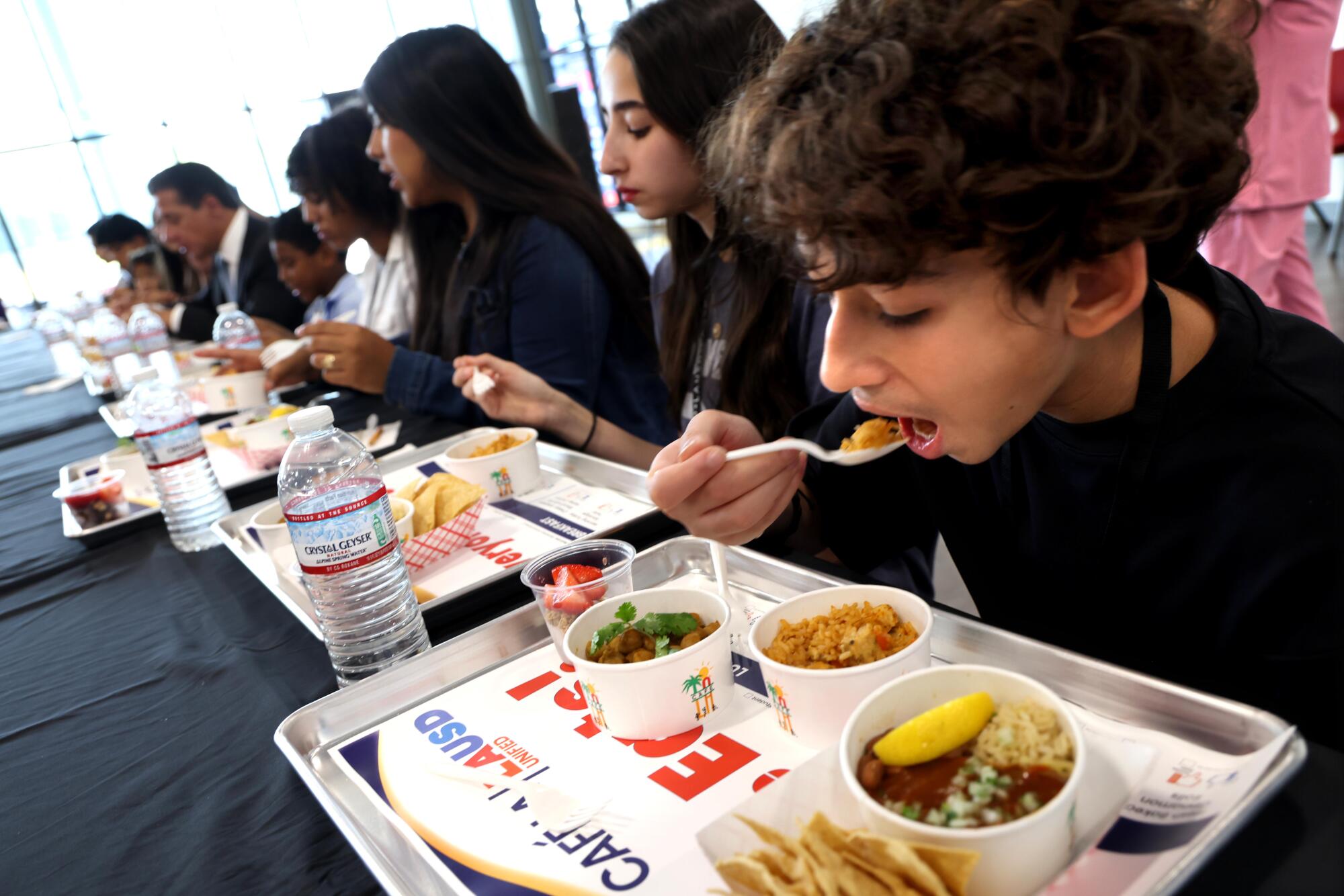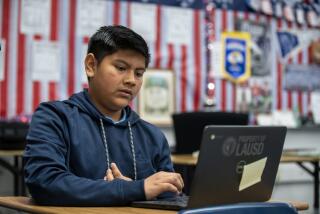
- Share via
“I get butterflies in my stomach,” said Alberto Angulo of the first day of school.
He’s a fourth-grade teacher at Main Street Elementary in South Los Angeles. And he’s far from alone in his nervous excitement.
For students and parents, the first day of school Monday at Los Angeles Unified was a crush of new schedules, new teachers and new things to learn, along with a modicum of excitement — and those familiar butterflies. And then around lunchtime — a magnitude 4.4 quake. By early afternoon the district said no damage was reported but the quake apparently triggered some real-life campus earthquake drills, adding to the jitters of the day.
For Angulo, his hint of first-day nervousness combined with the thrill of meeting new students, setting his classroom rules and recruiting students to his folklorico group.
“We can teach that traditional Mexican folk dance, which is something that I’m very passionate about, since that’s part of my culture,” said Angulo, who is starting his ninth year at the school and will have 22 students with him in Room 22.
Demeras Tillman dropped off her three elementary school children at Main Street, a school she has come to rely on.
“They actually care for the kids,” Tillman said. “We’ve had nothing but great support from people in the office to the teachers, everybody’s understanding and helpful.”
Veronica Cortez calmly and cheerfully welcomed 4-year-olds confronting their first day of school in transitional kindergarten. A few were eagerly digging into a breakfast of milk, apple and cinnamon bun, but a boy named Axel, nattily dressed in new khakis and a green shirt, was wailing: “I want my mom” and finally plopped the side of his head on the table in front of his chair.
At the Girls Academic Leadership Academy in the University Park neighborhood near USC, students walked onto their new campus, a refurbished LAUSD administration building. The students at the grade six-12 school had formerly used a portion of the Los Angeles High campus.
Rose Agamegwa, a college and career counselor, described the change as “liberating” for the girls and staff to have their own campus.
Staff at Bandini Street Elementary in San Pedro cheered, shook clappers and waved pom-poms to welcome the new 4- and 5-year-olds as parents crowded in front of the school’s gate, waving, taking photos and calling out goodbyes, unable to enter school grounds.
“Usually he’s upset when he gets up, but today he was ready to fly out of bed,” said Claudia Reyes as she stood outside the gate with her kindergarten son, Legend.
Challenges ahead
For the Los Angeles Unified School District the opening of the 2024-25 academic year is also about taking on renewed challenges.
Supt. Alberto Carvalho, entering the third full school year of his administration, is confronting lagging student achievement, declining enrollment, school safety worries, absenteeism and budget constraints.
He was up at 4:30 a.m. for an early start at a bus yard, then on to Main Street Elementary and a roster of other campuses.
Carvalho has hailed the rise in state test scores at every grade level that took the math and English assessments, although students are struggling to reach pre-pandemic levels. Attendance is following a similar trendline — much better but still in need of improvement.
Even though families were raving about her school, Main Street Principal Eva Rodriguez-Chavez said she has had to cope with declining enrollment, just like most other local schools. And she’s also pushing for better attendance rates, just as at other schools.
“My message to parents today: Please bring your child every day on time. We can’t support, we can’t do our job if they’re not here. If you’re worried, like, ‘I’m not sure how my child is feeling,’ we’ve got a full-time nurse who will check it out and make that determination with you.”
Chronic absenteeism — defined as missing at least 10% of the school year — soared when pandemic-shuttered campuses reopened in spring 2021. Just over 45% of students were chronically absent in 2021-22. The percentage dropped to 36.5% the following year, in 2022-23, the most recent year for which data have been posted. These numbers far exceed pre-pandemic levels, which already were considered high.
For Jordan High senior Katherine Castro, the 2024 academic year embodies the familiar as well as the new — and portends memorable moments ahead.
“It’s like a fresh new start and I try to reflect on the year before and what I can do better,” said Katherine, who is looking forward to senior events — like a trip to Disneyland — and who intends to join the first college-going generation of her family. “It feels nice to go back to school, especially since this is my last year.”
Getting to school
There is a complex infrastructure behind getting schools opened and students into class. And one important element for many students is the school bus.
Over the years, budget cutting limited daily bus service almost exclusively to students in magnet programs — meant to promote integration — and for students with disabilities. Yet there are about 25,000 empty seats on existing routes as school opens and officials have decided to try to fill them as a new service to families.
The district is advertising “transportation for all.” What that has meant is that parents can contact the transportation division to request an available seat if a bus stops where that student needs to go. This year the transportation division also has tried to add stops based purely on demand.
“It’s about how to be more efficient with the resources we have,” said transportation director Daniel Kang. “So we’ve brought in several routing experts, consultants, to provide their solutions and using our routing software as well.”
Some 59 operating buses are electric — with 250 expected to be in service by the end of year. They cost twice as much — about $350,000 apiece — and require the construction of charging centers, but are expected to save money over time in fuel costs, while also reducing pollution.
Families can coordinate transportation needs through the district’s online “parent portal.”
There’s definitely room for improvement in the view of L.A. parents who took part in a recent survey commissioned by HopSkipDrive, a tech-based transportation vendor.
About 40% of parents who drive their children to and from school say these obligations have caused them to miss work, with a similar number saying the task has interfered with their ability to seek out or accept new job opportunities. And 44% of those who drive to and from school said that
“navigating and waiting in the pick-up or drop-off lane is one of the most stressful parts of their day.”
Keeping students in school
The district accelerated an outreach campaign that includes home visits. AI-enhanced software that was supposed to provide reminders and suggest resources has been shelved after the company that created it cratered financially.
Another strategy offers students and families support through wellness clinics such as the one that just opened adjacent to Jordan High in Watts. It will serve students as well as an estimated 1,000 nearby community members who can walk in or make appointments.
The needs are especially acute at Jordan. Compared with elsewhere in the school system, families in that area have the highest rates of asthma, the largest number of emergency-room visits for assaults, the greatest eligibility for Medi-Cal services and the most pressing need for dental care, said Ron Tanimura, the district’s director of student medical services and Medi-Cal programs.
Katherine, the Jordan High student, said that the clinic provides help and privacy for students, whether for contraceptive services or required physicals for sports.

“There’s going to be more athletes this year,” said Katherine, who plans to study forensics in college. In the past, some girls who wanted to be on the soccer team “didn’t do their physical, so they weren’t a part of it, because they didn’t have a clinic to go to.”
She also appreciates the mental health component.
“Having the wellness clinic is like you have another place to go to that’s not necessarily inside the school, because maybe you’re insecure about other students seeing you.”
School safety

Officials view a pending cellphone ban as a major safety upgrade — mobile devices have been used to organize fights and drug sales on or near campuses. They hope to reverse a significant rise in fights and drugs on campus.
The district has tried to make campuses safer from outside threats by limiting entry and installing surveillance cameras. Threats inside a campus — such as bullying and vaping — are supposed to be managed through greater counseling resources and restorative justice, through which students who treat others badly or break rules are supposed to take responsibility for their actions and attempt to make amends.
The role of school police remains a topic of intense debate. Since mid-2020, officers have been limited to off-campus patrols, entering only to make arrests, conduct investigations or respond to an emergency situation.
One faction of students and parents wants to entirely eliminate the school police department, saying their presence traumatizes students and makes them feel unsafe.
Countering them are pro-police parents who, by the end of the last school year, had collected about 5,000 signatures on a petition calling for school police to be returned to campus.
“We’re here as parents fighting for more security and safety in the schools,” said Diana Guillen, a leader within the district’s parent-advisory committees at a school board meeting this month.
“All these programs that you’re doing truly don’t have an impact,” Guillen said. “I think if you want to take school police away, it has to be once the programs are already functioning — not when you’re experimenting with them. Because you’re playing with our kids lives.”
Meeting basic needs: Food

School food has a poor reputation and L.A. Unified richly deserved it for years — combining poor nutrition with sketchy taste. It did not help that, for a time, the district built new schools without working kitchens, relying instead on trucked-in entrees assembled in a central kitchen and then reheated at the school.
But a succession of efforts has improved the menu. This year’s annual taste-testing of new offerings took place at the new kitchen at Belvedere Middle School in East L.A.
Students sampled and rated an acai bowl with fresh fruit and a cheesy jalapeno biscuit with hot honey chicken. A nod to cultural diversity appeared in the birria bowl and arroz con pollo. And vegans could try chickpea masala or a fresh bar with fruit, vegetables and hummus.
All produce is sourced within 200 miles, central kitchen supervisor Javier Gutierrez said proudly.

A $65,000 “combi” oven allowed cafeteria staff to follow a two-step process for making fresh cinnamon rolls — one temperature for the dough to rise and a different setting for the cooking, explained culinary supervisor Jamie Ginsburg.
Salik Mian, a junior at Chatsworth High — and a self-described picky eater who used to eat only white rice at Chinese restaurants, savored his first bite: “I love that actually.”
More to Read
Sign up for Essential California
The most important California stories and recommendations in your inbox every morning.
You may occasionally receive promotional content from the Los Angeles Times.













